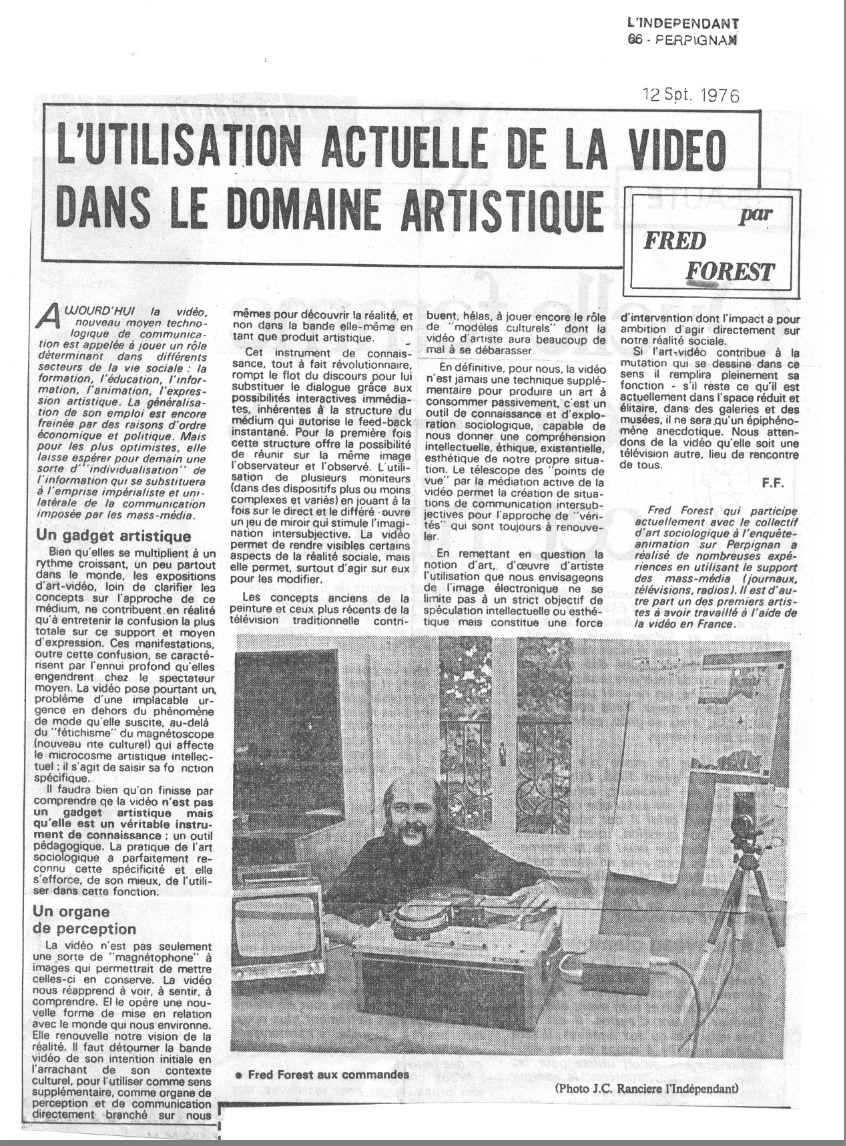Portapack / Créations vidéos
"La cabine téléphonique" and "Le mur d'Arles" were Fred Forest's very first videotapes.
The management of Sony France, whom he had approached on several occasions, entrusted him with a 1/2 inch, black and white Portapak, with which he was to work for ten years...
"La cabine téléphonique"was originally a document shot in real time, without editing, from the window of his third-floor council flat in L'Haÿ-les-Roses, on the outskirts of Paris. In this pioneering work, the artist depicts the sociological reality of his daily environment, focusing attention on the only telephone box in the district, available to the residents. The phone box and its successive users are visually linked to the tree that dominates it, like a giant aerial symbolising the world of communication. By this time, social reality, communication and networking were already emerging as major themes in the artist's practice.
"Le mur d'Arles" (The Wall of Arles) is an amusing visual diversion, playing on the curiosity of passers-by in a busy avenue in this town in the south of France. Passers-by are irresistibly drawn along the pavement by a mysterious event that seems to be taking place behind a fence...
With these two videos made in 1967, Fred Forest establishes himself as the 1st artist to have used video in France, and even in Europe...
1967 La cabine téléphonique
Along with Le mur d'Arles, this is one of Fred Forest's very first videotapes.
The management of Sony France, which he had approached on several occasions, entrusted him with a in 1967, a 1/2-inch, black-and-white Portapak, with which he worked for ten years...
Along with "Le mur d'Arles", this was one of Fred Forest's very first videotapes.
In 1967, the management of Sony France, whom he had approached on several occasions, entrusted him with a 1/2-inch black-and-white Portapak, with which he was to work for ten years...
On the very day he received the black-and-white Portapak ½ inch, Fred Forest returned to his home in the Paris suburb of L'Haÿ-les-Roses to experiment with the Sony camera, filming the street from the third-floor kitchen of his council apartment. "La cabine téléphonique" is a real-time, unedited document filmed from the window. For the audio, he tunes his transistor between two frequencies, producing random fading. His window overlooks a T-shaped street intersection, the center of which is occupied by a telephone booth, around which the document he creates revolves with the traffic of cars and passers-by. Occasionally, one of the passers-by crosses the network of all these trajectories and reaches the booth, where he has obviously gone to satisfy his need to communicate. Above the cabin and in its prolongation rises a magnificent tree whose leaves shimmer in the wind, and whose visual abstraction the artist accentuates by playing with the focal length of the lens, restoring what is for him the world of communication. In this pioneering work, the artist depicts the sociological reality of his daily environment in the Paris suburbs of the 60s, where people go about their business and do their shopping. He focuses attention on the neighborhood's only telephone booth, which is available to residents. The phone booth and its successive users are visually linked to the tree that dominates it, like a giant antenna symbolizing the world of communication. By this time, social reality, communication and networking had already emerged as major themes in the artist's practice.
1967 Le mur d'Arles
Along with "La cabine téléphonique", this was one of the very first videotapes Fred Forest made using the Sony Portapak.
During a stay in Arles, Fred Forest was struck by a palisade on which people walking along the sidewalk rushed to stick their eyes in the gaps. The result, it seems, is a kind of strange ballet. "Le mur d'Arles" is an amusing visual diversion, playing on the curiosity of passers-by on a busy avenue in this southern French town. Passers-by are irresistibly drawn along a sidewalk by a mysterious event that seems to be taking place behind a palisade...
Fred Forest is struck by this palisade, on which people rush to stick their eyes in the gaps. By mimicry, they seem to create a kind of strange ballet. By removing the audio from the scene, the artist introduces a rupture of meaning in his video, making the infernal noise of earth-moving machinery digging a huge hole disappear.

LONG BIOGRAPHY OF FRED FOREST
Fred Forest has a special place in contemporary art. Both by his personality and by his pioneering practices which mark his work. He is mainly known today for having used one by one most of the communication media that have appeared over the last fifty years. He is co-founder of three artistic movements: those of sociological art, the aesthetics of communication and ethics in art.
He represented France at the 12th São Paulo Biennale (Communication Prize) in 1973, at the 37th Venice Biennale in 1976 and at Documenta 6 in Kassel in 1977.
EXHIBITION AT THE CENTRE POMPIDOU FROM JANUARY 24 TO OCTOBER 14, 2024










